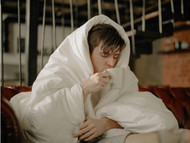Fungal Pathogens: What You Need to Know
Jun 25th 2024
Fungi is a part of our natural world, and they are vital in maintaining the balance of some ecosystems and environments. However, there are fungi that can be troublesome for human beings, as they can cause infections and disease that can sometimes be fatal.
These fungal pathogens often affect skin, hair, and nails, but there are other pathogens that can affect our bodies on a deeper level. They can affect our respiratory systems, urinary tract, and other body parts especially if our immune systems are weakened or compromised.
Of these, some of the most common and dangerous are black mold and candida. These fungi can affect the body differently, and they can grow in the home or in any environment where they have access to food and where the conditions are ideal for them to thrive.
Black Mold
This is a fungus that is naturally present in the environment. Often it can appear green or black, but when is black it refers to Stachybotrys chartarum which can spread on materials that have lots of cellulose, such as paper, wood, and drywall. Fruits that are starting to rot have a lot of cellulose, and often you will see black mold grow on the surface of these rotten fruits or vegetables.
You will also find black mold in areas where there is no direct sunlight, but there is sufficient warmth and moisture for a spore to spread. If you have damp or water damaged basements or floors, black mold can thrive in these environments.
So how does it spread? Since black mold is present in the environment, the mold spores can enter your home through doors, windows, HVAC vents, and even pets. Once they find an environment that can enable them to spread, then it will start to grow.
When black mold colonies are present in your home, you can experience the following symptoms:
- Sneezing
- Coughing
- Eye irritation
- Nasal congestion
- Digestive issues
- Brain fog
- Headaches
- Joint pain
- Fatigue
- And more.
If you are immuno-compromised, or you have asthma or similar respiratory issues, it could worsen your symptoms.
Candida Yeast
The Candida yeast causes candidiasis, a yeast infection that affects the skin, mouth, throat, guts, and the vagina. Though the symptoms may sometimes be minimal and do not affect how people live, they can have other complications that can seriously impact a person’s life.
Candida is normally present on the skin, but sometimes diet and medication can affect the levels of yeast in the body. This can cause dryness in the skin that can reduce healthy bacteria and cause the Candida yeast to multiply.
Medication such as antibiotics, steroids, contraceptives, and other medicines that increase dryness in the mouth or throat areas can increase the risk for developing Candidiasis. Diets high in sugar and carbohydrates also have a similar effect.
For those who are suffering from diabetes, cancer, or a compromised immune system, yeast infections are also much more common because of the reduction of good bacteria on their skin.
The symptoms of Candidiasis can be different depending on where the infection is. For the throat, mouth, and esophagus the symptoms include:
- Red patches on inner cheeks, tongue, mouth, and throat
- Redness or soreness on the skin surrounding mouth
- Cotton like-feeling in the mouth
- Loss of taste
- Pain when swallowing
For yeast infections in the vagina area, the symptoms include:
- Burning or itching sensation in the area
- Vaginal discharge that is thick, white, or watery but odor-free
- Redness and soreness in the area
Treatments for Fungal Infections
You can explore different treatments for fungal infections caused by Candida and black mold, and you can ask your physician to recommend creams and other medical treatments that can deal with the infection.
However, the best treatment is still prevention, and one of the best ways to do so is to improve your immune response. There are nasal sprays and homeopathic treatments for Candida such as CitiDrops and Sinus Defense and dietary supplements that can improve your immunity against mold and yeast.
Another way to manage mold is through regular cleaning and maintenance of your home and environment. A sanitizer fogger can reduce mold spores in the air, as it can sanitize your indoor air. It can reduce spores and mycotoxins in the environment, and could improve your chances of developing a yeast infection as it can sanitize the air around you.
Candida on the other hand, is not spread through the air, but through direct contact with a surface or skin that has candidiasis. In this case, a sanitizer fogger may not do much, and the best way to reduce the risk of spreading candidiasis through surface contact is to sanitize all surfaces with cleaning wipes that can remove fungi and bacteria.
Using EC3 Wipes along with a sanitizer fogger to clean your home regularly can significantly decrease mold and yeast infections in your home.
You Can Control Fungal Pathogens
If you want homeopathic supplements and tools such as sprays, foggers, and kits, visit MicroBalance for a complete list of anti mold defense for your home and body.



